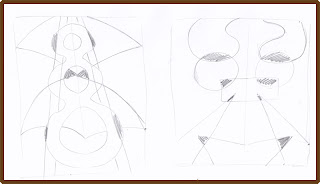This is a Lesson B05 of a Drawspace Art program. It suggests the method of drawing with only one line. Which means that the moment the pencil touches the paper - it doesn't leave it until the sketch is done. And you have to draw without looking at the paper. Sounds difficult, right? It does to me.
As you know, I usually carefully read the lesson before I actually start drawing something.
And while reading this one I thought to myself, how on earth am I going to do blind drawing? Obviously, Brenda, the author of this program, considered these doubts of her students and she gave this great advice: ".. move your pencil very slowly in the same direction as your eyes...".
And then it hit me! One's eye is a great measurement tool, when you learn how to use it. You draw as you watch. You start a line and when your eyes stop - your hand stops. Your eyes follow a curving line - your hand does the same.
And as long as your hand and your eye work together - look-draw-stop-look-draw-stop - the exercise is being done. And since this lesson is about doing the exercise and not about creating a perfect form (at least not at this point) then it's all good.
So the idea is to draw any object without the pencil leaving the paper and without looking too.
In both cases your eyes don't move from the object you draw!!!
So let's start with the first part.
I took a plastic cup and started drawing.
On my first attempt I cheated on the last minute.
So I did some more. Only on my 6th attempt I did something that slightly resembles a glass. Probably.
After that I moved to the challenge.
And, surprisingly, my very first sketch was pretty bearable. I did some more - and they all were decent. You could actually say it's a drinking glass.
And that made me really happy.
I can't say that I enjoyed this exercise but must remind myself to do it more often. Because it's a really great one and since I'm not looking to do great sketches at this moment but to learn, I'll let my perfectionism go so I could live with the ugly sketches.
(Brenda's) Tip of a day: Always let your pencil follow your eye: draw-stop-draw-stop. Use your eyes as a measuring tool.
Dalia


















